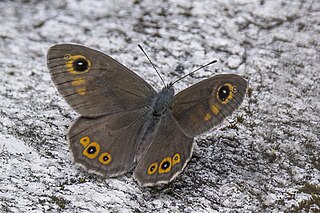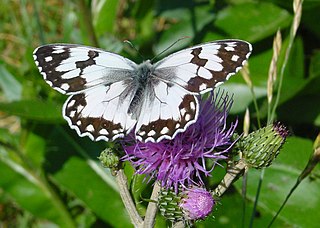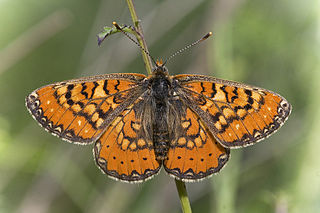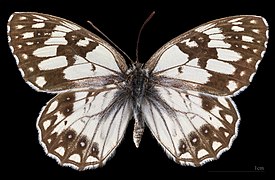
Melanargia galathea, the marbled white, is a medium-sized butterfly in the family Nymphalidae. Despite its common name and appearance, this butterfly is one of the "browns", of the subfamily Satyrinae.

The dark green fritillary is a species of butterfly in the family Nymphalidae. The insect has a wide range in the Palearctic realm - Europe, Morocco, Iran, Siberia, Central Asia, China, Korea, and Japan.

Aporia crataegi, the black-veined white, is a large butterfly of the family Pieridae. A. crataegi is widespread and common. Its range extends from northwest Africa in the west to Transcaucasia and across the Palearctic to Siberia and Japan in the east. In the south, it is found in Turkey, Cyprus, Israel, Lebanon and Syria. It is not usually present in the British Isles or northern Scandinavia.

Lasiommata megera, the wall or wall brown, is a butterfly in the family Nymphalidae. It is widespread in the Palearctic realm with a large variety of habitats and number of generations a year.

Lasiommata maera, the large wall brown, is a butterfly in the family Nymphalidae.

Lopinga achine, the woodland brown, is a Palearctic butterfly in the family Nymphalidae.

The de Prunner's ringlet is a member of the subfamily Satyrinae of the family Nymphalidae.

Coenonympha arcania, the pearly heath, is a butterfly species belonging to the family Nymphalidae.

Coenonympha hero, the scarce heath, is a butterfly species belonging to the family Nymphalidae.

Melanargia lachesis, the Iberian marbled white, is a butterfly species belonging to the family Nymphalidae.

Melanargia ines, the Spanish marbled white, is a butterfly species belonging to the family Nymphalidae. It can be found on the Iberian Peninsula and western North Africa.

Polyommatus escheri, Escher's blue, is a butterfly of the family Lycaenidae. It is found in Southern Europe and Morocco.

Chazara briseis, the hermit, is a butterfly species belonging to the family Nymphalidae. It can be found in North Africa, southern Europe, Asia Minor, the Caucasus, Kazakhstan, Central Asia through Afghanistan, and north-western China and Tuva. It is found on steppe and in other dry grassy places between 500 and 2,500 meters.

Melanargia russiae, or Esper's marbled white, is a butterfly in the family Nymphalidae. It is found in Spain, Portugal, south-eastern France, Italy, the Balkans, southern Russia, the Caucasus and western Siberia.

Melanargia is a genus of butterflies belonging to the family Nymphalidae and the subfamily Satyrinae.

Euphydryas desfontainii, the Spanish fritillary, is a species of butterfly in the family Nymphalidae. It is found in France, Portugal, Spain, Morocco and western Algeria in North Africa.

Chazara prieuri, the southern hermit, is a butterfly species belonging to the family Nymphalidae. It can be found in Morocco and Spain.

Chazara persephone, the dark rockbrown, is a butterfly species belonging to the family Nymphalidae. It can be found from Crimea across the Caucasus and north of the Middle East to Iran; from the southern Urals across Kazakhstan to the southern Altai and west Siberia.

Arethusana is a butterfly genus from the subfamily Satyrinae of the brush-footed butterfly family (Nymphalidae). It is composed of only one species, Arethusana arethusa, the false grayling.

Melanargia larissa, the Balkan marbled white, is a butterfly in the family Nymphalidae. It is found from south-eastern Europe and Asia Minor to Transcaucasia and north-western Iran. The habitat consists of dry grasslands, scrubby hillsides and grassy woodland glades. Adults are on wing from mid-May to July in one generation per year.






















